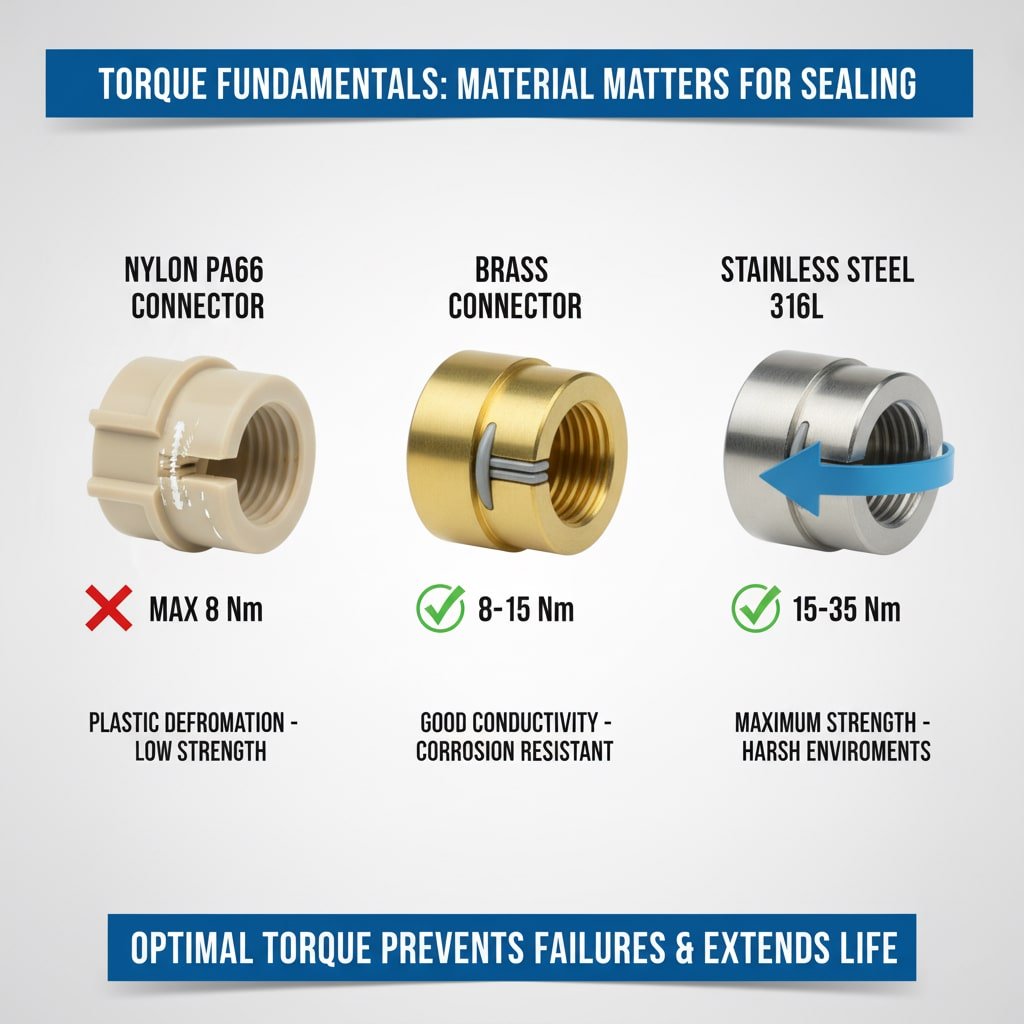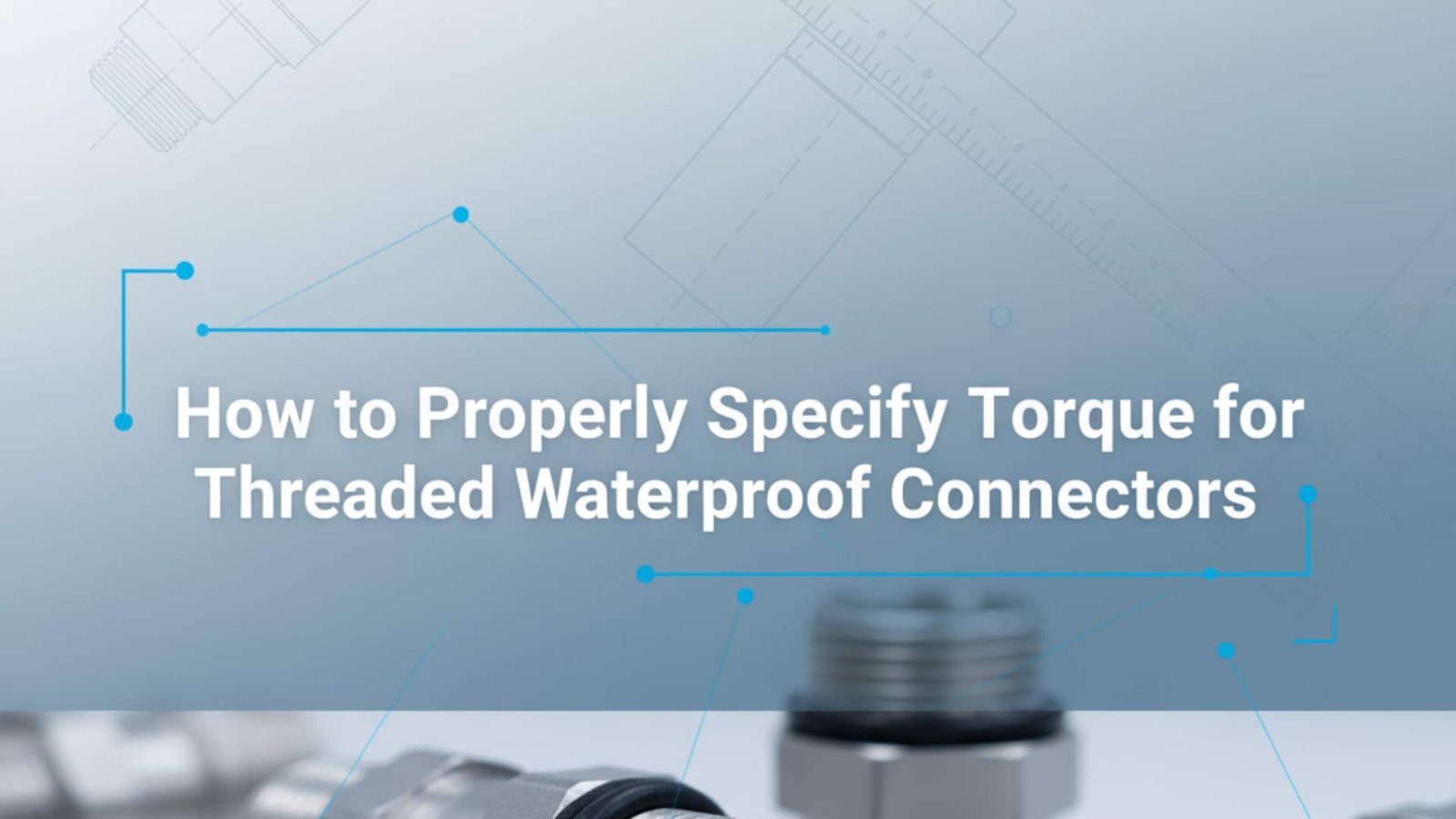Over-tightened connectors crack under pressure, while under-tightened ones leak catastrophically – and both mistakes cost thousands in equipment damage and project delays. The difference between proper and improper torque specification can make or break your waterproof connector’s performance in critical applications. Korrekt vridmomentspecifikation för gängade vattentäta anslutningar kräver matchande materialegenskaper, gänglutning och tätningskrav för att uppnå optimal kompression utan komponentskador - vanligtvis mellan 5-50 Nm beroende på anslutningsstorlek och material. After a decade of helping engineers at Bepto Connector avoid costly torque-related failures, I’ve seen how this fundamental specification decision impacts everything from IP-klassning1 to long-term reliability.
Innehållsförteckning
- What Factors Determine Proper Torque Specifications?
- How Do Different Materials Affect Torque Requirements?
- What Are the Consequences of Incorrect Torque Application?
- How to Calculate Optimal Torque Values for Your Application?
- Vilka verktyg och tekniker säkerställer korrekt vridmomentsapplicering?
- VANLIGA FRÅGOR
What Factors Determine Proper Torque Specifications?
Understanding torque fundamentals prevents expensive field failures and warranty claims. Proper torque specifications depend on thread size, material hardness, seal compression requirements, and environmental conditions – with brass connectors typically requiring 20-30% less torque than stainless steel equivalents due to material properties.

Primary Torque Influencing Factors
Thread Geometry and Pitch: Metric threads require different torque calculations than NPT-gängor2 due to varying thread angles and pitch ratios. M12 connectors typically need 8-12 Nm, while M20 versions require 15-25 Nm for optimal sealing.
Seal Material and Compression: O-ring materials directly impact required torque values. EPDM seals need 15-20% more compression force than NBR seals to achieve equivalent IP ratings, translating to higher torque requirements.
Housing Material Properties: The connector housing material determines maximum allowable torque before thread damage occurs. Nylon housings limit torque to 5-8 Nm, while brass allows 15-30 Nm, and stainless steel can handle 25-50 Nm safely.
Miljöhänsyn
Temperature cycling affects torque retention significantly. David, a procurement manager from a Munich automotive supplier, learned this the hard way when his outdoor sensor connectors loosened after thermal cycling from -20°C to +80°C. We solved his problem by specifying 20% higher initial torque values and adding thread-locking compound3, eliminating his seasonal maintenance requirements.
Vibration and Shock Loads: High-vibration environments require additional torque margin or mechanical locking features to prevent loosening. Marine applications often specify 25-30% higher torque values than static installations.
How Do Different Materials Affect Torque Requirements?
Material selection fundamentally changes your torque specification approach. Brass connectors require 8-15 Nm torque range, stainless steel needs 15-35 Nm, while nylon housings must stay below 8 Nm to prevent thread stripping – with each material offering distinct advantages for specific applications.
Material-Specific Torque Guidelines
| Material | Vridmomentområde (Nm) | Viktiga egenskaper | Typiska tillämpningar |
|---|---|---|---|
| Nylon PA66 | 3-8 | Lightweight, chemical resistant | Indoor automation, food processing |
| Mässing | 8-15 | Excellent conductivity, corrosion resistant | Marine, telecommunications |
| Rostfritt stål 316L | 15-35 | Maximum strength, harsh environments | Chemical plants, offshore |
| Aluminiumlegering | 10-20 | Weight-sensitive applications | Flyg- och rymdindustrin, fordonsindustrin |
Understanding Material Behavior Under Torque
Plastic Deformation Limits: Nylon connectors exhibit plastic deformation4 at relatively low torque values. Exceeding 8 Nm typically causes permanent thread damage, making torque control critical for these cost-effective solutions.
Metal Fatigue Considerations: Brass and stainless steel connectors can handle repeated torque cycling, but proper lubrication becomes essential. Dry threads increase required torque by 30-40% compared to properly lubricated connections.
Hassan, who manages a petrochemical facility in Dubai, initially specified standard torque values for his stainless steel explosion-proof connectors. After experiencing several seal failures in high-temperature areas, we increased his torque specification to 28 Nm and added high-temperature thread compound. His facility has now operated 24 months without a single connector-related leak, saving over $75,000 in potential downtime costs.
What Are the Consequences of Incorrect Torque Application?
Torque mistakes create cascading failures that impact entire systems. Under-torquing causes immediate seal failure and IP rating loss, while over-torquing leads to thread damage, stress cracking, and premature connector replacement – both scenarios typically cost 10-50x more than proper initial specification.

Under-Torque Failure Modes
Seal Compression Inadequacy: Insufficient torque fails to compress O-rings properly, allowing moisture ingress that damages sensitive electronics. IP68-rated connectors can drop to IP54 or lower with just 20% torque reduction.
Lossning av vibrationer: Under-torqued connections loosen progressively under vibration, creating intermittent electrical connections and eventual complete failure.
Effekter av termisk cykling: Temperature changes cause differential expansion that further loosens inadequately torqued connections, accelerating failure progression.
Over-Torque Damage Patterns
Thread Stripping: Excessive torque strips threads in softer materials, creating permanent damage requiring complete connector replacement.
Housing Cracking: Over-torqued plastic housings develop stress cracks that propagate over time, eventually causing catastrophic seal failure.
Extrusion av tätningar: Excessive compression forces O-rings out of their grooves, creating leak paths and reducing seal effectiveness.
Analys av kostnadspåverkan
Field failures from improper torque typically cost:
- Emergency replacement parts: 3-5x normal pricing
- Technician callout fees: $200-500 per incident
- System downtime: $1,000-10,000 per hour depending on application
- Skada på anseende: Omätbar långsiktig påverkan
How to Calculate Optimal Torque Values for Your Application?
Systematic torque calculation prevents guesswork and ensures reliable performance. Calculate optimal torque using the formula: T = K × D × F, where T is torque (Nm), K is the nut factor5 (0.15-0.25), D is nominal diameter (mm), and F is desired clamping force (N) – then adjust for material properties and environmental factors.
Steg-för-steg-beräkningsprocess
Step 1: Determine Base Torque Requirements
Start with manufacturer specifications, then adjust for your specific conditions. Standard M16 brass connectors typically specify 12 Nm ± 2 Nm as baseline values.
Step 2: Apply Material Correction Factors
- Stainless steel: Multiply by 1.3-1.5
- Nylon: Multiply by 0.4-0.6
- Aluminum: Multiply by 0.8-1.0
Step 3: Environmental Adjustments
- High vibration: Add 20-30%
- Temperature cycling: Add 15-25%
- Chemical exposure: Consult material compatibility charts
Praktiskt beräkningsexempel
For an M20 stainless steel marine connector:
- Base torque: 18 Nm
- Material factor: 1.4 (stainless steel)
- Environmental factor: 1.25 (marine vibration)
- Final torque: 18 × 1.4 × 1.25 = 31.5 Nm
Vilka verktyg och tekniker säkerställer korrekt vridmomentsapplicering?
Proper tools and techniques guarantee consistent, repeatable results. Use calibrated torque wrenches with ±4% accuracy for critical applications, apply torque in 2-3 progressive steps, and always lubricate threads with appropriate compounds to achieve specified values consistently.
Essential Torque Application Tools
Torque Wrenches: Digital torque wrenches provide the highest accuracy for critical applications. Beam-type wrenches work well for routine installations where ±10% accuracy suffices.
Torque Adapters: Crow’s foot adapters and angle heads enable torque application in confined spaces, though they require torque value corrections based on adapter geometry.
Thread Lubricants: Proper lubrication reduces torque scatter by 40-60%. Use manufacturer-specified compounds or high-quality anti-seize for consistent results.
Bästa praxis för installation
Progressive Torque Application: Apply torque in 2-3 steps: 30%, 70%, then 100% of final value. This technique ensures even stress distribution and optimal seal compression.
Torque Sequence for Multiple Connectors: When installing multiple connectors on the same panel, use a star pattern to distribute stress evenly and prevent panel warping.
Verifieringsförfaranden: Always verify final torque after initial installation. Thermal cycling and material relaxation can reduce effective torque by 10-15% within the first 24 hours.
Åtgärder för kvalitetskontroll
Document torque values for critical installations to enable troubleshooting and maintenance planning. Create installation procedures that specify:
- Required tools and calibration dates
- Torque values and application sequence
- Thread preparation requirements
- Final verification steps
Slutsats
Proper torque specification for threaded waterproof connectors requires systematic consideration of materials, environmental conditions, and application requirements. The investment in proper torque tools and procedures pays dividends through reduced field failures, extended connector life, and maintained IP ratings. At Bepto Connector, we’ve helped thousands of engineers avoid costly torque-related failures by providing detailed specifications and application guidance. Remember: the few minutes spent calculating and applying proper torque values can save weeks of troubleshooting and thousands in replacement costs. When in doubt, consult your connector manufacturer’s specifications and adjust for your specific application conditions 😉
VANLIGA FRÅGOR
Q: What happens if I overtighten a waterproof connector?
A: Over-tightening causes thread stripping, housing cracks, and seal extrusion, leading to immediate or progressive seal failure. Plastic connectors are especially vulnerable, with damage occurring above 8 Nm for most nylon housings.
Q: How do I know if my torque wrench is accurate enough?
A: Use torque wrenches with ±4% accuracy for critical applications and ±10% for general installations. Calibrate annually or after 5,000 cycles, whichever comes first, and verify calibration with known torque standards.
Q: Should I use thread sealant on waterproof connectors?
A: Use thread lubricant, not sealant, on waterproof connectors. Thread sealants can interfere with O-ring sealing and make future disassembly difficult. Proper lubricants reduce torque scatter and ensure consistent clamping force.
Q: Why do my connectors keep loosening in vibration environments?
A: Insufficient initial torque or lack of thread locking causes vibration loosening. Increase torque by 20-30% for high-vibration applications and consider thread-locking compounds or mechanical locking features for critical connections.
Q: Can I reuse waterproof connectors after disassembly?
A: Yes, if disassembled properly and components show no damage. Inspect threads, O-rings, and housing for wear or damage. Replace O-rings and apply fresh thread lubricant before reassembly using original torque specifications.
-
Learn about the Ingress Protection (IP) rating system and what the numbers signify for protection against solids and liquids. ↩
-
Explore the differences between National Pipe Taper (NPT) and metric thread standards, including their angles and applications. ↩
-
Understand the chemical principles behind thread-locking compounds and how they prevent fasteners from loosening due to vibration. ↩
-
Discover the materials science concept of plastic deformation, where a material is permanently reshaped by stress. ↩
-
Read an in-depth guide on the “nut factor” (K) and how it accounts for friction in torque-tension calculations. ↩



